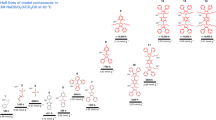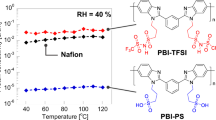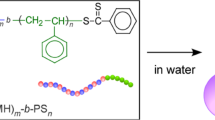Abstract
We synthesized a styrene-based polymer containing fused expanded pyridinium (FEP) moieties as side chains for an anion exchange membrane. FEPs were incorporated into poly(4-azidomethylstyrene) via copper-catalyzed alkyne-azide cycloaddition (click chemistry) to yield an FEP content of 10.5 mol%, which depended on the FEP feed ratio. The FEP polymer membrane containing 10.5 mol% of FEP exhibited high hydroxide conductivity of 123.4 (±13.3) mS cm–1 with a relatively low ion-exchange capacity of 0.77 (±0.03) at 80 °C under 80% relative humidity. Density functional theory studies revealed that FEP is a considerably soft acid owing to substantial delocalization of the positive charge in the rigid π structure. The high ion conductivity and low ion-exchange capacity can be attributed to weak interactions between the hard base (hydroxide ions) and soft acid (FEP).
This is a preview of subscription content, access via your institution
Access options
Subscribe to this journal
Receive 12 print issues and online access
$259.00 per year
only $21.58 per issue
Buy this article
- Purchase on Springer Link
- Instant access to full article PDF
Prices may be subject to local taxes which are calculated during checkout





Similar content being viewed by others
References
Luo T, Abdu S, Wessling M. Selectivity of ion exchange membranes: a review. J Membr Sci. 2018;555:429–54.
Vincent I, Bessarabov D. Low cost hydrogen production by anion exchange membrane electrolysis: a review. Renew Sustain Energy Rev. 2018;81:1690–704.
Pan ZF, An L, Zhao TS, Tang ZK. Advances and challenges in alkaline anion exchange membrane fuel cells. Prog Energy Combust Sci. 2018;66:141–75.
Pan Y, Jiang K, Sun X, Ma S, So Y-M, Ma H, et al. Facilitating ionic conduction for anion exchange membrane via employing star-shaped block copolymer. J Membr Sci. 2021;630:119290.
Liu Z, Bai L, Miao S, Li C, Pan J, Jin Y, et al. Structure-property relationship of poly(2,6-dimethyl-1,4-phenylene oxide) anion exchange membranes with pendant sterically crowded quaternary ammoniums. J Membr Sci. 2021;638:119693.
Xu J, Ju M, Chen X, Meng L, Ren J, Lei J, et al. High alkaline stability and long-term durability of imidazole functionalized poly(ether ether ketone) by incorporating graphene oxide/metal-organic framework complex. Int J Hydrog Energy. 2022;47:25755–68.
Xiao Y, Xu J, Hu L, Wang H, Gao L, Peng S, et al. Advanced anion-selective membranes with pendant quaternary ammonium for neutral aqueous supporting redox flow battery. J Membr Sci. 2022;659:120748.
Jiang T, Wang C, Wang T, Wang X, Wang X, Li X, et al. Imidazolium structural isomer pyrazolium: a better alkali-stable anion conductor for anion exchange membranes. J Membr Sci. 2022;660:120843.
Jang H, Hossain MA, Sutradhar SC, Ahmed F, Choi K, Ryu T, et al. Anion conductive tetra-sulfonium hydroxides poly(fluorenylene ether sulfone) membrane for fuel cell application. Int J Hydrog Energy. 2017;42:12759–67.
Miller HA, Bouzek K, Hnat J, Loos S, Bernäcker CI, Weißgärber T, et al. Green hydrogen from anion exchange membrane water electrolysis: a review of recent developments in critical materials and operating conditions. Sustain Energy Fuels. 2020;4:2114–33.
Peron J, Mani A, Zhao X, Edwards D, Adachi M, Soboleva T, et al. Properties of Nafion® NR-211 membranes for PEMFCs. J Membr Sci. 2010;356:44–51.
Wu L, Pan Q, Varcoe JR, Zhou D, Ran J, Yang Z, et al. Thermal crosslinking of an alkaline anion exchange membrane bearing unsaturated side chains. J Membr Sci. 2015;490:1–8.
Huang J, Yu Z, Tang J, Wang P, Tan Q, Wang J, et al. A review on anion exchange membranes for fuel cells: anion-exchange polyelectrolytes and synthesis strategies. Int J Hydrog Energy. 2022;47:27800–20.
Hren M, Božič M, Fakin D, Kleinschek KS, Gorgieva S. Alkaline membrane fuel cells: anion exchange membranes and fuels. Sustain Energy Fuels. 2021;5:604–37.
Knauth P, Pasquini L, Narducci R, Sgreccia E, Becerra-Arciniegas RA, Di Vona ML. Effective ion mobility in anion exchange ionomers: relations with hydration, porosity, tortuosity, and percolation. J Membr Sci. 2021;617:118622
Mandal M, Huang G, Kohl PA. Highly conductive anion-exchange membranes based on cross-linked poly (norbornene): vinyl addition polymerization. ACS Appl Energy Mater. 2019;2:2447–57.
Tanaka M, Koike M, Miyatake K, Watanabe M. Anion conductive aromatic ionomers containing fluorenyl groups. Macromolecules. 2010;43:2657–9.
Pan J, Chen C, Zhuang L, Lu J. Designing advanced alkaline polymer electrolytes for fuel cell applications. Acc Chem Res. 2012;45:473–81.
Kim Y, Wang Y, France-Lanord A, Wang Y, Wu Y-CM, Lin S, et al. Ionic highways from covalent assembly in highly conducting and stable anion exchange membrane fuel cells. J Am Chem Soc. 2019;141:18152–9.
Weiber EA, Jannasch P. Anion-conducting polysulfone membranes containing hexa-imidazolium functionalized biphenyl units. J Membr Sci. 2016;520:425–33.
Sun Z, Lin B, Yan F. Anion-exchange membranes for alkaline fuel-cell applications: the effects of cations. ChemSusChem. 2018;11:58–70.
Ma Q, Zhang H, Zhou C, Zheng L, Cheng P, Nie J, et al. Single lithium-ion conducting polymer electrolytes based on a super-delocalized polyanion. Angew Chem Int Ed. 2016;55:2521–5.
Marino MG, Melchior JP, Wohlfarth A, Kreuer KD. Hydroxide, halide and water transport in a model anion exchange membrane. J Membr Sci. 2014;464:61–71.
Pearson RG. Hard and soft acids and bases. J Am Chem Soc. 1963;85:3533–9.
Grew KN, Chu D, Chiu WK. Ionic equilibrium and transport in the alkaline anion exchange membrane. J Electrochem Soc. 2010;157:B1024.
Lei Q, Li K, Bhattacharya D, Xiao J, Kole S, Zhang Q, et al. Counterion condensation or lack of solvation? Understanding the activity of ions in thin film block copolymer electrolytes. J Mater Chem A. 2020;8:15962–75.
Motoishi Y, Tanaka N, Fujigaya T. Synthesis and anion conductivity of anion-exchange membrane with fused expanded pyridinium structure as cationic moiety. Chem Lett. 2021;50:1504–7.
Yang W, Chen J, Yan J, Liu S, Yan Y, Zhang Q. Advance of click chemistry in anion exchange membranes for energy application. J Polym Sci. 2022;60:627–49.
Frisch MJ, Trucks GW, Schlegel HB, Scuseria GE, Robb MA, Cheeseman JR, et al. Gaussian 09 Citation. Wallingford CT: Gaussian, Inc.; 2004.
García-Cuadrado D, Cuadro AM, Barchín BM, Nunez A, Caneque T, Alvarez-Builla J, et al. Palladium-mediated functionalization of heteroaromatic cations: comparative study on quinolizinium cations. J Org Chem. 2006;71:7989–95.
Kosugi M, Sasazawa K, Shimizu Y, Migita T. Reactions of allyltin compounds III. Allylation of aromatic halides With allyltributyltin in the presence of tetrakis (triphenylphosphine) palladium (O). Chem Lett. 1977;6:301–2.
Tuli SK, Roy AL, Elgammal RA, Zawodzinski TA, Fujiwara T. Polystyrene-based anion exchange membranes via click chemistry: improved properties and AEM performance. Polym Int. 2018;67:1302–12.
Haldón E, Nicasio MC, Pérez PJ. Copper-catalysed azide–alkyne cycloadditions (CuAAC): an update. Org Biomol Chem. 2015;13:9528–50.
Chu X, Liu L, Huang Y, Guiver MD, Li N. Practical implementation of bis-six-membered N-cyclic quaternary ammonium cations in advanced anion exchange membranes for fuel cells: synthesis and durability. J Membr Sci. 2019;578:239–50.
Hwang CW, Park H-M, Oh CM, Hwang TS, Shim J, Jin C-S. Synthesis and characterization of vinylimidazole-co-trifluoroethylmethacrylate-co-divinylbenzene anion-exchange membrane for all-vanadium redox flow battery. J Membr Sci. 2014;468:98–106.
Hagesteijn KFL, Jiang S, Ladewig BP. A review of the synthesis and characterization of anion exchange membranes. J Mater Sci. 2018;53:11131–50.
Fukuta K. Electrolyte Materials for AMFCs and AMFC Performance. AMFC Workshop. 2011.
Abouzari-Lotf E, Jacob MV, Ghassemi H, Zakeri M, Nasef MM, Abdolahi Y, et al. Highly conductive anion exchange membranes based on polymer networks containing imidazolium functionalised side chains. Sci Rep. 2021;11:3764.
Mohanty AD, Bae C. Mechanistic analysis of ammonium cation stability for alkaline exchange membrane fuel cells. J Mater Chem A. 2014;2:17314–20.
Hugar KM, You W, Coates GW. Protocol for the quantitative assessment of organic cation stability for polymer electrolytes. ACS Energy Lett. 2019;4:1681–6.
Cui K, Mali KS, Ivasenko O, Wu D, Feng X, Walter M, et al. Squeezing, then stacking: from breathing pores to three-dimensional ionic self-assembly under electrochemical. Control Angew Chem, Int Ed. 2014;53:12951–4.
Devadoss A, Chidsey CED. Azide-modified graphitic surfaces for covalent attachment of alkyne-terminated molecules by “click” chemistry. J Am Chem Soc. 2007;129:5370–1.
Zhang J, Zhang K, Liang X, Yu W, Ge X, Shehzad MA, et al. Self-aggregating cationic-chains enable alkaline stable ion-conducting channels for anion-exchange membrane fuel cells. J Mater Chem A. 2021;9:327–37.
Pan J, Chen C, Li Y, Wang L, Tan L, Li G, et al. Constructing ionic highway in alkaline polymer electrolytes. Energy Environ Sci. 2014;7:354–60.
Xu S, Wu W, Wan R, Wei W, Li Y, Wang J, et al. Tailoring the molecular structure of pyridine-based polymers for enhancing performance of anion exchange electrolyte membranes. Renew Energy. 2022;194:366–77.
Fang J, Wu Y, Zhang Y, Lyu M, Zhao J. Novel anion exchange membranes based on pyridinium groups and fluoroacrylate for alkaline anion exchange membrane fuel cells. Int J Hydrog Energy. 2015;40:12392–9.
Yang Z, Liu Y, Guo R, Hou J, Wu L, Xu T. Highly hydroxide conductive ionomers with fullerene functionalities. Chem Commun. 2016;52:2788–91.
Xiao Y, Zhang M, Dong D, Yang Z, Cao Y, Wang K, et al. Preparation of branch polyethyleneimine (BPEI) crosslinked anion exchange membrane based on poly(styrene-b-(ethylene-co-butylene)-b-styrene) (SEBS). Macromol Mater Eng. 2021;306:2000693.
Wang Z, Li Z, Chen N, Lu C, Wang F, Zhu H. Crosslinked poly (2,6-dimethyl-1,4-phenylene oxide) polyelectrolyte enhanced with poly (styrene-b-(ethylene-co-butylene)-b-styrene) for anion exchange membrane applications. J Membr Sci. 2018;564:492–500.
Wang JT-W, Hsu SL-C. Enhanced high-temperature polymer electrolyte membrane for fuel cells based on polybenzimidazole and ionic liquids. Electrochim Acta. 2011;56:2842–6.
Hamada T, Yoshimura K, Takeuchi K, Watanabe S, Zhao Y, Hiroki A, et al. Synthesis and characterization of 4-vinylimidazolium/styrene-cografted anion-conducting electrolyte membranes. Macromol Chem Phys. 2021;222:2100028.
Emmanuel K, Erigene B, Cheng C, Mondal AN, Hossain MM, Khan MI, et al. Facile synthesis of pyridinium functionalized anion exchange membranes for diffusion dialysis application. Sep Purif Technol. 2016;167:108–16.
Granzhan A, Ihmels H, Tian M. The benzo[b]quinolizinium ion as a water-soluble platform for the fluorimetric detection of biologically relevant analytes. ARKIVOC. 2015;2015:494–523.
Saito M, Kawaharasaki S, Ito K, Yamada S, Hayamizu K, Seki S. Strategies for fast ion transport in electrochemical capacitor electrolytes from diffusion coefficients, ionic conductivity, viscosity, density and interaction energies based on HSAB theory. RSC Adv. 2017;7:14528–35
Acknowledgements
This study was supported in part by the SPRING program (No. JPMJSP2136), ACT-X (No. AJ219069-a01) and CREST (No. AJ199002) from Japan Science and Technology Agency (JST), Japan; the Nanotechnology Platform Project from the Ministry of Education, Culture, Sports, Science, and Technology (MEXT), Japan; and KAKENHI (No. JP18H01816) and the Bilateral Program (No. AJ190078) from the Japan Society for the Promotion of Science (JSPS), Japan.
Author information
Authors and Affiliations
Corresponding author
Ethics declarations
Conflict of interest
The authors declare no competing interests.
Additional information
Publisher’s note Springer Nature remains neutral with regard to jurisdictional claims in published maps and institutional affiliations.
Supplementary information
Rights and permissions
Springer Nature or its licensor (e.g. a society or other partner) holds exclusive rights to this article under a publishing agreement with the author(s) or other rightsholder(s); author self-archiving of the accepted manuscript version of this article is solely governed by the terms of such publishing agreement and applicable law.
About this article
Cite this article
Motoishi, Y., Tanaka, N. & Fujigaya, T. Postmodification of highly delocalized cations in an azide-based polymer via copper-catalyzed cycloaddition for anion exchange membranes. Polym J 55, 171–180 (2023). https://doi.org/10.1038/s41428-022-00730-z
Received:
Revised:
Accepted:
Published:
Issue Date:
DOI: https://doi.org/10.1038/s41428-022-00730-z



